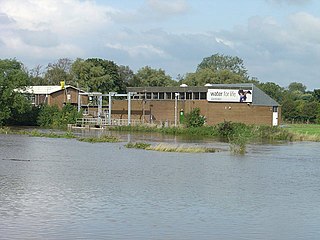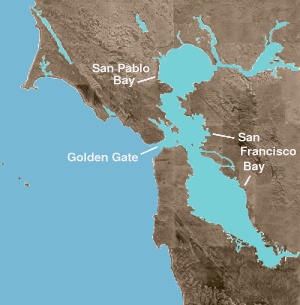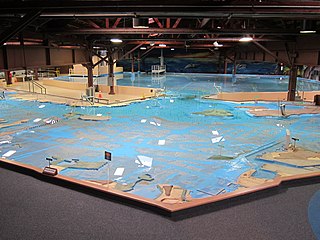Related Research Articles

Water extraction is the process of taking water from any source, either temporarily or permanently, for flood control or to obtain water for, for example, irrigation. The extracted water could also be used as drinking water after suitable treatment.

Groundwater is the water present beneath Earth's surface in rock and soil pore spaces and in the fractures of rock formations. About 30 percent of all readily available fresh water in the world is groundwater. A unit of rock or an unconsolidated deposit is called an aquifer when it can yield a usable quantity of water. The depth at which soil pore spaces or fractures and voids in rock become completely saturated with water is called the water table. Groundwater is recharged from the surface; it may discharge from the surface naturally at springs and seeps, and can form oases or wetlands. Groundwater is also often withdrawn for agricultural, municipal, and industrial use by constructing and operating extraction wells. The study of the distribution and movement of groundwater is hydrogeology, also called groundwater hydrology.

The San Joaquin River is the longest river of Central California. The 366-mile (589 km) long river starts in the high Sierra Nevada and flows through the rich agricultural region of the northern San Joaquin Valley before reaching Suisun Bay, San Francisco Bay, and the Pacific Ocean. An important source of irrigation water as well as a wildlife corridor, the San Joaquin is among the most heavily dammed and diverted of California's rivers.

The Governor Edmund G. Brown California Aqueduct is a system of canals, tunnels, and pipelines that conveys water collected from the Sierra Nevada and valleys of Northern and Central California to Southern California. Named after California Governor Edmund Gerald "Pat" Brown Sr., the over 400-mile (640 km) aqueduct is the principal feature of the California State Water Project.

The Carquinez Strait is a narrow tidal strait located in the Bay Area of Northern California, United States. It is part of the tidal estuary of the Sacramento and the San Joaquin rivers as they drain into the San Francisco Bay. The strait is eight miles (13 km) long and connects Suisun Bay, which receives the waters of the combined rivers, with San Pablo Bay, a northern extension of the San Francisco Bay.

The Sacramento–San Joaquin River Delta, or California Delta, is an expansive inland river delta and estuary in Northern California. The delta is formed at the western edge of the Central Valley by the confluence of the Sacramento and San Joaquin rivers and lies just east of where the rivers enter Suisun Bay, which flows into San Francisco Bay, then the Pacific Ocean via San Pablo Bay. The Delta is recognized for protection by the California Bays and Estuaries Policy. Sacramento–San Joaquin Delta was designated a National Heritage Area on March 12, 2019. The city of Stockton is located on the San Joaquin River at the eastern edge of the delta. The total area of the Delta, including both land and water, is about 1,100 square miles (2,800 km2). Its population is around 500,000.
Saltwater intrusion is the movement of saline water into freshwater aquifers, which can lead to groundwater quality degradation, including drinking water sources, and other consequences. Saltwater intrusion can naturally occur in coastal aquifers, owing to the hydraulic connection between groundwater and seawater. Because saline water has a higher mineral content than freshwater, it is denser and has a higher water pressure. As a result, saltwater can push inland beneath the freshwater. In other topologies, submarine groundwater discharge can push fresh water into saltwater.

The delta smelt is an endangered slender-bodied smelt, about 5 to 7 cm long, in the family Osmeridae. Endemic to the upper Sacramento-San Joaquin Estuary of California, it mainly inhabits the freshwater-saltwater mixing zone of the estuary, except during its spawning season, when it migrates upstream to fresh water following winter "first flush" flow events. It functions as an indicator species for the overall health of the Delta's ecosystem. Delta Smelt are usually found at temperatures of less than 25 °C and prefer temperatures of around 20 °C. They are euryhaline but occur mostly at salinities of 0–7 practical salinity units.

Located in northern California, the Suisun Marsh has been referred to as the largest brackish water marsh on west coast of the United States of America. The marsh land is part of a tidal estuary, and subject to tidal ebb and flood. The marsh is home to many species of birds and other wildlife, and is formed by the confluence of the Sacramento and San Joaquin rivers between Martinez and Suisun City, California and several other smaller, local watersheds. Adjacent to Suisun Bay, the marsh is immediately west of the legally defined Sacramento-San Joaquin Delta as well as part of the San Francisco Bay estuary.

The Pajaro River is a U.S. river in the Central Coast region of California, forming part of the border between San Benito and Santa Clara Counties, the entire border between San Benito and Santa Cruz County, and the entire border between Santa Cruz and Monterey County. Flowing roughly east to west, the river empties into Monterey Bay, west of Watsonville, California.
The Peripheral Canal was a series of proposals starting in the 1940s to divert water from California's Sacramento River, around the periphery of the San Joaquin-Sacramento River Delta, to uses farther south. The canal would have attempted to resolve a problem with the quality of water pumped south. Pumps create such a powerful suction that the boundary between freshwater to saltwater has shifted inland, negatively affecting the environment. The pumps have increased by 5 to 7 million acre-feet the amount of water exported each year to the Central Valley and Southern California. However, the peripheral canal as proposed would have reduced the overall freshwater flow into the Delta and move the freshwater-saltwater interface further inland, causing damage to Delta agriculture and ecosystems.

The San Francisco Estuary together with the Sacramento–San Joaquin River Delta represents a highly altered ecosystem. The region has been heavily re-engineered to accommodate the needs of water delivery, shipping, agriculture, and most recently, suburban development. These needs have wrought direct changes in the movement of water and the nature of the landscape, and indirect changes from the introduction of non-native species. New species have altered the architecture of the food web as surely as levees have altered the landscape of islands and channels that form the complex system known as the Delta.

California's interconnected water system serves almost 40 million people and irrigates over 5,680,000 acres (2,300,000 ha) of farmland. As the world's largest, most productive, and potentially most controversial water system, it manages over 40 million acre-feet (49 km3) of water per year. Use of available water averages 50% environmental, 40% agricultural and 10% urban, though this varies considerably by region and between wet and dry years. In wet years, "environmental" water averages 61%, while in dry years it averages 41%, and can be even lower in critically dry years.

The Jones Tract is an island containing Lower Jones Tract and the Upper Jones Tract in the Sacramento-San Joaquin River Delta, fifteen kilometres west of Stockton. The 4,900 ha island is bounded on the north by Empire Cut, on the northeast by Whiskey Slough, on the southeast by Trapper Slough, and on the west, Middle River. The tracts are bifurcated by the parallel running Mokelumne Aqueduct, West Lower Jones Road, and a railroad originally built by the Achison Topeka and Santa Fe Railroad, which now carries freight trains of the BNSF Railway and Amtrak California's San Joaquin. It is in San Joaquin County, and managed by Reclamation District 2039. It appears on 1913 and 1952 United States Geological Survey maps of the area.

The U.S. Army Corps of Engineers Bay Model is a working hydraulic scale model of the San Francisco Bay and Sacramento-San Joaquin River Delta System. While the Bay Model is still operational, it is no longer used for scientific research but is instead open to the public alongside educational exhibits about Bay hydrology. The model is located in the Bay Model Visitor Center at 2100 Bridgeway Blvd. in Sausalito, California.

In hydrology, a lens, also called freshwater lens or Ghyben-Herzberg lens, is a convex-shaped layer of fresh groundwater that floats above the denser saltwater and is usually found on small coral or limestone islands and atolls. This aquifer of fresh water is recharged through precipitation that infiltrates the top layer of soil and percolates downward until it reaches the saturated zone. The recharge rate of the lens can be summarized by the following equation:

The historical and ongoing droughts in California result from various complex meteorological phenomena, some of which are not fully understood by scientists.

The Old River is a tidal distributary of the San Joaquin River that flows for about 40 miles (64 km) through the Sacramento–San Joaquin River Delta in Northern California. The Old River was once the main channel of the San Joaquin until navigation and flood control projects in the late 19th and 20th century fixed the San Joaquin to its present course past Stockton. It diverges from the San Joaquin near Tracy, about 38 miles (61 km) upstream from Antioch, and first runs west towards Mountain House, then north to rejoin the San Joaquin 13 miles (21 km) above Antioch. The river is lined with levees that prevent flooding of the adjacent Delta islands, many of which lie below sea level. The Middle River runs east of and roughly parallel to Old River. False River diverges from Old River about a mile (1.6 km) above the Old River's mouth and runs westward to join the San Joaquin at a point closer to Antioch. Part of the Old River forms the boundary between San Joaquin County on the east and Contra Costa County to the west.

Restore the Delta is a campaign, based in Stockton, California that advocates for restoring the Sacramento-San Joaquin Delta also known as the San Francisco Bay-Delta Estuary. It began in 2006 working towards education and outreach to help Californians recognize the Delta as part of California's heritage. Currently, there are up to 40,000 members throughout California of both residents and various organizations working towards the same goal.

Coastal Hydrogeology is a branch of Hydrogeology that focuses on the movement and the chemical properties of groundwater in coastal areas. Coastal Hydrogeology studies the interaction between fresh groundwater and seawater, including seawater intrusion, sea level induced groundwater level fluctuation, submarine groundwater discharge, human activities and groundwater management in coastal areas.
References
- ↑ "Seawater intrusions in groundwater". Lenntech.
- ↑ Abd-Elaty, Ismail; Abd Elhamid, Hany Farhat; Javadi, Akbar (November 7, 2016). "Numerical analysis of the effects of changing hydraulic parameters on saltwater intrusion in coastal aquifers". Engineering Computations. 33 (8): 2546–2564. doi:10.1108/EC-11-2015-0342. ProQuest 1830615685.
- ↑ Survey, California Water Science Center, U.S. Geological. "Seawater Intrusion - SGMA - USGS CA Water Science Center". ca.water.usgs.gov.
{{cite web}}: CS1 maint: multiple names: authors list (link) - ↑ Bray, Benjamin S.; Yeh, William W.-G. (March 1, 2008). "Improving Seawater Barrier Operation with Simulation Optimization in Southern California". Journal of Water Resources Planning and Management. 134 (2): 171–180. doi:10.1061/(ASCE)0733-9496(2008)134:2(171).
- ↑ "Saltwater Intrusion in Los Angeles Area Coastal Aquifers--the Marine Connection - FS 030-02". pubs.usgs.gov.
- ↑ "Water Factor 21" (PDF). Archived from the original (PDF) on September 11, 2016.
- ↑ Alexander, Kurtis (May 19, 2021). "State plans $30 million wall to stop saltwater intrusion into delta — drought fallout". SF Chronicle. Retrieved April 27, 2022.
- ↑ Chenoweth, Jonathan (August 2008). "Water, water everywhere". New Scientist. 199 (2670): 28–32. doi:10.1016/S0262-4079(08)62124-7.
- ↑ Lund, Jay; Hanak, Ellen; Fleenor, William; Bennett, William; Howitt, Richard (2010). book: Comparing Futures for the Sacramento, San Joaquin Delta Book Comparing Futures for the Sacramento, San Joaquin Delta. University of California Press. ISBN 9780520945371.
- 1 2 "Sacramento-San Joaquin Delta and Salinity". Water Education Foundation. June 22, 2020.
- ↑ "Suisun Marsh". Water Education Foundation. June 22, 2020.